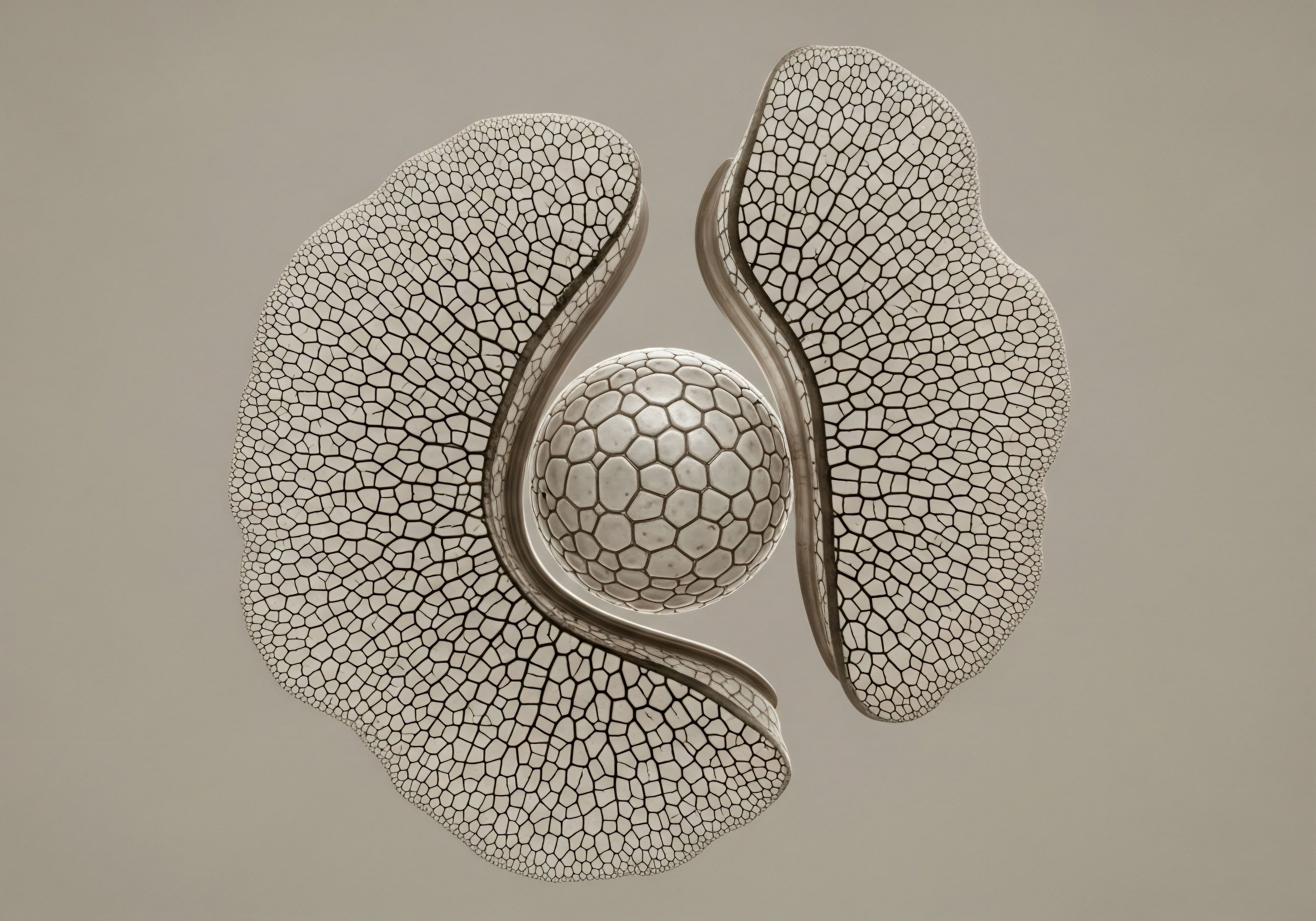

Fundamentals
When you experience shifts in your body’s rhythm, a subtle yet persistent sense of unease can settle in. Perhaps you notice a decline in your usual energy, a change in your sleep patterns, or a feeling that your vitality has diminished.
These sensations, often dismissed as simply “getting older” or “stress,” can signal deeper shifts within your intricate biological systems. It is a common experience to feel disconnected from your former self, grappling with symptoms that seem to defy easy explanation. This personal journey of recognizing altered well-being is the starting point for understanding hormonal optimization protocols.
Your body operates through a sophisticated network of chemical messengers, known as hormones. These substances, produced by endocrine glands, travel through your bloodstream, influencing nearly every cell, tissue, and organ. They orchestrate processes from metabolism and mood to sleep and reproductive function. When this delicate balance is disrupted, the impact can be widespread, affecting your physical sensations, mental clarity, and emotional state. Recognizing these internal signals is the first step toward reclaiming your optimal function.
Hormones act as the body’s internal messaging service, directing essential functions throughout your systems.

Understanding Hormonal Balance
The concept of hormonal balance refers to the precise equilibrium required for your endocrine system to operate effectively. This balance is not static; it constantly adjusts in response to internal and external cues. For instance, your body’s stress response involves a cascade of hormonal releases, preparing you for perceived threats. After the threat subsides, these hormone levels should return to their baseline. Chronic stress, however, can keep these systems activated, leading to prolonged hormonal dysregulation.
Age-related changes frequently influence hormonal production. As individuals age, the output of certain hormones, such as testosterone and growth hormone, naturally declines. For women, the transition through perimenopause and menopause involves significant fluctuations and eventual reductions in estrogen and progesterone. These physiological shifts can manifest as a variety of symptoms, including reduced muscle mass, increased body fat, changes in bone density, altered sleep quality, and shifts in mood.

The Endocrine System’s Interconnectedness
The endocrine system functions as a highly integrated network. No single hormone operates in isolation. Consider the hypothalamic-pituitary-gonadal (HPG) axis, a prime example of this interconnectedness. The hypothalamus, located in the brain, releases gonadotropin-releasing hormone (GnRH), which signals the pituitary gland.
The pituitary then releases luteinizing hormone (LH) and follicle-stimulating hormone (FSH), which in turn stimulate the gonads (testes in men, ovaries in women) to produce sex hormones like testosterone, estrogen, and progesterone. This intricate feedback loop ensures that hormone levels are tightly regulated.
Disruptions at any point along this axis can cascade, affecting overall hormonal output. For example, chronic stress can suppress GnRH release, leading to lower LH and FSH, and subsequently, reduced sex hormone production. Understanding these feedback mechanisms is fundamental to appreciating how targeted interventions can restore systemic equilibrium.

Why Consider Hormonal Optimization?
Many individuals seek hormonal optimization protocols to address symptoms that diminish their quality of life. These symptoms might include persistent fatigue, reduced physical performance, diminished libido, difficulty maintaining a healthy body composition, or cognitive fogginess. The goal of these protocols extends beyond symptom management; it aims to restore physiological function to a more youthful or optimal state, supporting long-term vitality and well-being.
The approach to hormonal optimization is deeply personal. It begins with a thorough assessment of your unique biological profile, including comprehensive laboratory testing and a detailed review of your symptoms and health history. This personalized evaluation guides the selection of specific protocols, ensuring that interventions are tailored to your individual needs and biological responses.
Personalized hormonal optimization aims to restore physiological function for enhanced vitality.

Initial Assessment and Biomarkers
A comprehensive initial assessment involves evaluating various biomarkers. For men, this often includes total and free testosterone, estradiol, LH, FSH, and prostate-specific antigen (PSA). For women, assessments might include estradiol, progesterone, testosterone, LH, FSH, and thyroid hormones. Beyond these direct hormonal measurements, metabolic markers such as fasting glucose, insulin, and lipid panels provide a broader picture of systemic health, as hormonal balance significantly influences metabolic function.
These laboratory values, combined with a detailed understanding of your lived experience and symptoms, form the basis for developing a precise and individualized protocol. The aim is to address the root causes of your symptoms, not merely to mask them.


Intermediate
Moving beyond the foundational understanding of hormonal systems, we delve into the specific clinical protocols designed to recalibrate endocrine function. These interventions are not one-size-fits-all solutions; they are carefully selected and adjusted based on individual biological profiles and therapeutic goals. The aim is to support the body’s inherent capacity for balance, guiding it back to a state of optimal function.

Targeted Hormonal Support Applications
Hormonal support protocols are applied to distinct patient groups, addressing their unique physiological needs. The primary applications involve supporting male hormone optimization, female hormone balance, and foundational concepts shared by both. Each protocol is designed with specific agents and administration methods to achieve precise biochemical recalibration.

Testosterone Replacement Therapy for Men
For men experiencing symptoms associated with declining testosterone levels, often referred to as andropause or hypogonadism, Testosterone Replacement Therapy (TRT) can be a transformative intervention. Symptoms might include reduced energy, decreased muscle mass, increased body fat, diminished libido, and a general decline in well-being. The standard protocol frequently involves weekly intramuscular injections of Testosterone Cypionate, typically at a concentration of 200mg/ml. This method ensures consistent delivery and absorption of the hormone.
A comprehensive TRT protocol extends beyond simply administering testosterone. To maintain natural testicular function and fertility, Gonadorelin is often included. This peptide, administered via subcutaneous injections twice weekly, stimulates the pituitary gland to release LH and FSH, thereby preserving the testes’ ability to produce their own testosterone and sperm. Without this support, exogenous testosterone can suppress the HPG axis, leading to testicular atrophy and infertility.
Another crucial component is Anastrozole, an aromatase inhibitor. Testosterone can convert into estrogen in the body through the enzyme aromatase. Elevated estrogen levels in men can lead to side effects such as gynecomastia (breast tissue development), fluid retention, and mood changes.
Anastrozole, typically taken as an oral tablet twice weekly, helps to block this conversion, maintaining a healthy testosterone-to-estrogen ratio. Some protocols may also incorporate Enclomiphene to further support LH and FSH levels, offering an alternative or adjunct to Gonadorelin.
TRT for men involves a multi-component approach to restore testosterone levels while mitigating potential side effects.
Consider the analogy of a finely tuned engine. Testosterone is the primary fuel, but other components, like Gonadorelin and Anastrozole, act as critical regulators, ensuring the engine runs smoothly and efficiently without overheating or causing damage.

Testosterone Replacement Therapy for Women
Women also experience symptoms related to hormonal shifts, particularly during pre-menopausal, peri-menopausal, and post-menopausal phases. These symptoms can range from irregular cycles, mood changes, and hot flashes to reduced libido and bone density concerns. Testosterone support for women is administered at much lower doses than for men, reflecting physiological differences.
A common protocol involves Testosterone Cypionate, typically 10 ∞ 20 units (0.1 ∞ 0.2ml) weekly via subcutaneous injection. This micro-dosing approach helps to restore optimal testosterone levels without inducing virilizing side effects. Progesterone is another vital hormone, prescribed based on menopausal status. For women with an intact uterus, progesterone is essential to protect the uterine lining when estrogen is also being used, preventing endometrial hyperplasia. It also plays roles in mood, sleep, and bone health.
Pellet therapy offers a long-acting option for testosterone delivery in women. Small pellets, inserted subcutaneously, release a consistent dose of testosterone over several months. Anastrozole may be included with pellet therapy when appropriate, particularly if there is a tendency for testosterone to convert excessively to estrogen, or if the woman experiences estrogen-related symptoms.

Post-Therapy and Fertility Protocols for Men
For men who have discontinued TRT or are actively trying to conceive, specific protocols are implemented to restore natural hormonal production and spermatogenesis. Exogenous testosterone suppresses the body’s own production, so a structured approach is needed to reactivate the HPG axis.
This protocol typically includes Gonadorelin, which stimulates LH and FSH release, directly signaling the testes to resume testosterone and sperm production. Tamoxifen and Clomid, both selective estrogen receptor modulators (SERMs), are also utilized. These agents block estrogen’s negative feedback on the pituitary, leading to increased LH and FSH secretion. This surge in gonadotropins helps to kickstart endogenous testosterone production and support spermatogenesis. Anastrozole may be optionally included if estrogen levels rise excessively during this recovery phase.
The aim here is to gently coax the body’s own systems back into full operation, much like restarting a dormant system. This careful re-initiation helps to ensure a smoother transition and better long-term outcomes for natural hormonal function and fertility.

Growth Hormone Peptide Therapy
Growth hormone peptide therapy targets active adults and athletes seeking benefits such as anti-aging effects, muscle gain, fat loss, and improved sleep quality. These peptides are not human growth hormone (HGH) itself, but rather secretagogues that stimulate the body’s own pituitary gland to produce and release more growth hormone. This approach aims to leverage the body’s natural regulatory mechanisms.
Key peptides in this category include ∞
- Sermorelin ∞ A growth hormone-releasing hormone (GHRH) analog that stimulates the pituitary.
- Ipamorelin / CJC-1295 ∞ These peptides work synergistically; Ipamorelin is a growth hormone secretagogue, and CJC-1299 (without DAC) is a GHRH analog, both promoting pulsatile growth hormone release.
- Tesamorelin ∞ A GHRH analog approved for reducing visceral fat in specific conditions.
- Hexarelin ∞ Another growth hormone secretagogue, known for its potent effects.
- MK-677 ∞ An oral growth hormone secretagogue that increases growth hormone and IGF-1 levels.
These peptides are typically administered via subcutaneous injection, often before bedtime to align with the body’s natural pulsatile release of growth hormone during sleep. The benefits are often seen over several months of consistent use, supporting cellular repair, metabolic efficiency, and tissue regeneration.

Other Targeted Peptides
Beyond growth hormone secretagogues, other peptides address specific health concerns ∞
- PT-141 ∞ Used for sexual health, this peptide acts on melanocortin receptors in the brain to influence sexual desire and arousal. It offers a unique mechanism for addressing libido concerns in both men and women.
- Pentadeca Arginate (PDA) ∞ This peptide is gaining recognition for its role in tissue repair, healing processes, and inflammation modulation. It can support recovery from injuries and reduce systemic inflammatory responses, contributing to overall well-being.
The use of peptides represents a sophisticated approach to biochemical recalibration, leveraging the body’s own signaling pathways to achieve therapeutic outcomes. As with all hormonal interventions, precise dosing and careful monitoring are paramount to ensure safety and efficacy.


Academic
The long-term safety considerations for hormonal optimization therapies demand a rigorous, systems-biology perspective, moving beyond superficial discussions to analyze the intricate interplay of biological axes, metabolic pathways, and cellular signaling. Our exploration here delves into the deep endocrinology and clinical data, providing a comprehensive understanding of these complex interventions.

Long-Term Safety of Testosterone Optimization
The discussion surrounding the long-term safety of testosterone replacement therapy (TRT) has evolved significantly, particularly concerning cardiovascular health. Early observational studies and some initial trials raised concerns about potential adverse cardiovascular events. However, more recent, larger, and longer-duration studies offer a more nuanced picture.
A meta-analysis of multiple randomized controlled trials (RCTs) involving a substantial number of participants has indicated that TRT does not increase the risk of major adverse cardiovascular events (MACE), including myocardial infarction and stroke.
Some studies even suggest a reduced risk of MACE and overall mortality in men with low testosterone levels who receive TRT, particularly when testosterone levels are brought into a healthy range. This finding challenges earlier apprehensions and highlights the importance of well-designed, long-term clinical investigations.
The TRAVERSE study, a large ongoing clinical trial, is specifically designed to measure the time to MACE in hypogonadal men with increased cardiovascular risk, providing further robust data on this critical safety aspect. While some initial short-term studies showed an increased risk of cardiovascular events, particularly in older men with pre-existing heart conditions, these findings have been largely counterbalanced by more extensive research.

Hematocrit and Prostate Health Considerations
One well-documented side effect of TRT is an increase in hematocrit, the proportion of red blood cells in the blood. Elevated hematocrit can increase blood viscosity, potentially raising the risk of thrombotic events. Clinical monitoring of hematocrit levels is therefore essential, and dose adjustments or therapeutic phlebotomy may be necessary if levels become excessively high.
Studies indicate that while TRT can increase hematocrit, it does not consistently lead to pathological erythrocytosis, especially with transdermal preparations or when limited to hypogonadal patients.
Concerns regarding TRT and prostate health, specifically prostate cancer, have also been a subject of extensive research. Current evidence suggests that TRT does not increase the risk of developing prostate cancer in men without pre-existing disease.
For men with a history of prostate cancer, the decision to initiate TRT requires careful consideration and shared decision-making with a specialist, as data in this specific population are still evolving. Regular monitoring of prostate-specific antigen (PSA) levels remains a standard practice for men on TRT.

Female Hormonal Optimization and Safety
For women, the long-term safety of hormonal optimization, particularly estrogen and progesterone therapies, has been a topic of considerable debate, largely influenced by the Women’s Health Initiative (WHI) studies. These studies, while instrumental, initially led to widespread concern due to reported increases in breast cancer and cardiovascular events with certain combined hormone regimens.
Subsequent analyses and more recent research have refined our understanding. The timing of initiation, the specific type of hormones used (e.g. conjugated equine estrogens vs. bioidentical estradiol), and the route of administration (oral vs. transdermal) significantly influence the risk profile.
Oral estrogen therapy, particularly conjugated equine estrogens, has been associated with an increased risk of venous thromboembolism (VTE) and stroke. This risk is generally not observed with transdermal estrogen administration, which bypasses first-pass liver metabolism.

Breast Cancer Risk and Progesterone’s Role
The relationship between hormonal optimization and breast cancer risk is complex. Studies indicate that estrogen-only therapy in women who have had a hysterectomy may not increase breast cancer risk, and some research even suggests a reduction. However, combined estrogen and synthetic progestin therapy, particularly medroxyprogesterone acetate (MPA), has been linked to an increased risk of breast cancer, especially with longer durations of use (over 3-5 years).
The type of progestogen appears to be a critical factor. Observational studies suggest that micronized progesterone may carry a lower breast cancer risk compared to synthetic progestins, although randomized controlled trial data specifically comparing these progestogens on breast cancer outcomes are limited. This distinction underscores the importance of individualized therapy and careful selection of hormonal agents.
| Hormone Regimen | Cardiovascular Risk (VTE/Stroke) | Breast Cancer Risk | Endometrial Cancer Risk |
|---|---|---|---|
| Oral Estrogen Only | Increased (VTE, Stroke) | Potentially Reduced | Increased (if uterus intact) |
| Transdermal Estrogen Only | Lower/No Increase | Potentially Reduced | Increased (if uterus intact) |
| Estrogen + Synthetic Progestin | Increased (VTE, Stroke) | Increased | Reduced (if uterus intact) |
| Estrogen + Micronized Progesterone | Lower/Similar to Estrogen Only | Potentially Lower than Synthetic Progestin | Reduced (if uterus intact) |

Safety of Growth Hormone Peptide Therapies
Growth hormone peptide therapies, which stimulate endogenous growth hormone release, generally present a favorable safety profile when administered under medical supervision and at appropriate dosages. However, potential long-term considerations exist, primarily related to the effects of elevated growth hormone and IGF-1 levels.
Common side effects, often dose-dependent, include fluid retention (edema), joint pain (arthralgias), and carpal tunnel syndrome. These symptoms typically resolve with dose reduction. More significant concerns involve metabolic changes and potential mitogenic effects.

Metabolic and Mitogenic Considerations
Elevated growth hormone levels can influence glucose metabolism, potentially leading to insulin resistance or impaired glucose tolerance. Regular monitoring of blood glucose and HbA1c levels is therefore important during these therapies. This metabolic shift underscores the interconnectedness of the endocrine and metabolic systems.
A theoretical concern with growth hormone secretagogues is their potential mitogenic effect, meaning they could promote cell growth and division. This raises questions about the risk of new tumor formation or the progression of pre-existing malignancies. Long-term surveillance studies of adult growth hormone replacement therapy have generally not demonstrated an increased risk of cancer or mortality. However, individuals with a history of cancer or a strong family history should approach these therapies with caution and thorough medical evaluation.
| Category | Specific Consideration | Clinical Monitoring |
|---|---|---|
| Metabolic Health | Insulin resistance, impaired glucose tolerance, type 2 diabetes | Fasting glucose, HbA1c, insulin levels |
| Fluid Balance | Peripheral edema, carpal tunnel syndrome | Symptom assessment, physical examination |
| Musculoskeletal | Joint pain, muscle pain | Symptom assessment |
| Oncological Potential | Promotion of existing cancerous cells | Careful screening, regular cancer screenings |

Safety of Fertility-Stimulating Protocols
Protocols involving Gonadorelin, Tamoxifen, Clomid, and Anastrozole for fertility stimulation or post-TRT recovery in men are generally well-tolerated with a favorable safety profile. The side effects are typically mild and transient.
Clomid and Tamoxifen, as SERMs, have a good safety record in men. While women using Clomid can experience mood swings, men generally do not report this side effect. Mild side effects might include decreased libido, hot flashes, or hair loss, though these are infrequent and typically mild. Concerns about bone health with long-term Clomid use have been raised due to its estrogen receptor modulation, but most studies suggest improvements in bone mineral density.
Anastrozole, when used to manage estrogen levels, can lead to excessively low estrogen if not carefully dosed. Low estrogen in men can negatively impact bone density and lipid profiles. Therefore, regular monitoring of estradiol levels is important to ensure appropriate dosing.
The overarching principle across all hormonal optimization therapies is the necessity of individualized assessment, precise dosing, and ongoing clinical monitoring. This approach minimizes potential risks and maximizes therapeutic benefits, allowing individuals to pursue their health goals with confidence.

How Does Ongoing Monitoring Mitigate Long-Term Risks?
Ongoing clinical monitoring forms the bedrock of safe and effective hormonal optimization. This continuous oversight allows for real-time adjustments to protocols, addressing any emerging side effects or shifts in biological markers. Regular laboratory testing, coupled with a thorough review of subjective symptoms, creates a dynamic feedback loop that ensures the therapy remains aligned with the individual’s health goals and physiological responses.
For instance, in men on TRT, routine blood work includes not only testosterone and estradiol levels but also hematocrit and PSA. If hematocrit rises, the dosage of testosterone might be reduced, or a temporary pause in therapy might be considered. Similarly, if estradiol levels become too high, the Anastrozole dosage can be adjusted. This proactive management helps to prevent potential long-term complications.
In women receiving hormonal support, regular assessment of symptom relief, along with monitoring of relevant hormone levels and general health markers, guides therapeutic decisions. The goal is to use the lowest effective dose for the shortest necessary duration to achieve symptom resolution, particularly for combined estrogen-progestin therapies, to minimize potential risks.
For peptide therapies, monitoring involves assessing the desired clinical outcomes (e.g. improved body composition, sleep) alongside metabolic markers like glucose and IGF-1 levels. Any adverse effects, such as fluid retention or joint discomfort, prompt a re-evaluation of the dosage. This vigilant approach ensures that the benefits of these therapies are realized while maintaining a robust safety profile.

References
- Stuenkel, C. A. et al. “Optimizing hormone replacement therapy for postmenopausal women with type 2 diabetes ∞ a review.” Open Exploration Publishing, 2024.
- Corona, G. et al. “Testosterone Replacement Therapy ∞ Long-Term Safety and Efficacy.” Translational Andrology and Urology, vol. 5, no. 6, 2016, pp. 828 ∞ 841.
- Gleason, C. E. et al. “Long-term cognitive effects of menopausal hormone therapy ∞ Findings from the KEEPS Continuation Study.” PLoS Medicine, vol. 16, no. 10, 2019, e1002943.
- Yuen, K. C. J. et al. “The Effect of Testosterone on Cardiovascular Disease and Cardiovascular Risk Factors in Men ∞ A Review of Clinical and Preclinical Data.” Journal of Clinical Endocrinology & Metabolism, vol. 106, no. 3, 2021, pp. 837 ∞ 852.
- Nayeri, A. et al. “The Inverse Association between Testosterone Replacement Therapy and Cardiovascular Disease Risk ∞ A Systematic 25-year Review and Meta-Analysis Analysis of Prospective Cohort Studies from 1999 to 2024.” medRxiv, 2024.
- Stuenkel, C. A. et al. “Hormone Replacement Therapy.” StatPearls Publishing, 2024.
- Vasan, R. S. et al. “Adult Growth Hormone Deficiency ∞ Benefits, Side Effects, and Risks of Growth Hormone Replacement.” Frontiers in Endocrinology, vol. 3, 2012, p. 19.
- Prisk, J. “Unveiling the Hidden Dangers ∞ The Risks of Using Unapproved Peptides for Health and Performance Enhancement.” Prisk Orthopaedics and Wellness, 2024.
- Huijben, M. et al. “Selective Estrogen Receptor Modulators (SERMS) – Male Infertility Guide.” Andrology, 2023.
- Shoshany, O. et al. “Outcomes of anastrozole in oligozoospermic hypoandrogenic subfertile men.” Journal of Urology, 2017.

Reflection
Your personal health journey is a continuous exploration, a dynamic process of understanding and adapting. The knowledge shared here about hormonal optimization protocols serves as a guide, offering insights into the biological mechanisms that influence your vitality. It is a testament to the body’s remarkable capacity for healing and recalibration when provided with precise, targeted support.
Consider this information not as a definitive endpoint, but as a compass pointing toward a path of deeper self-awareness. Each individual’s biological system is unique, responding to interventions in its own way. The path to reclaiming optimal function is therefore highly personal, requiring careful observation, consistent monitoring, and a willingness to work in partnership with clinical guidance.
The power to influence your well-being resides within your understanding of your own internal landscape. By engaging with this knowledge, you are taking a proactive step toward a future where your biological systems operate with renewed vigor, allowing you to experience life with uncompromised energy and clarity.



